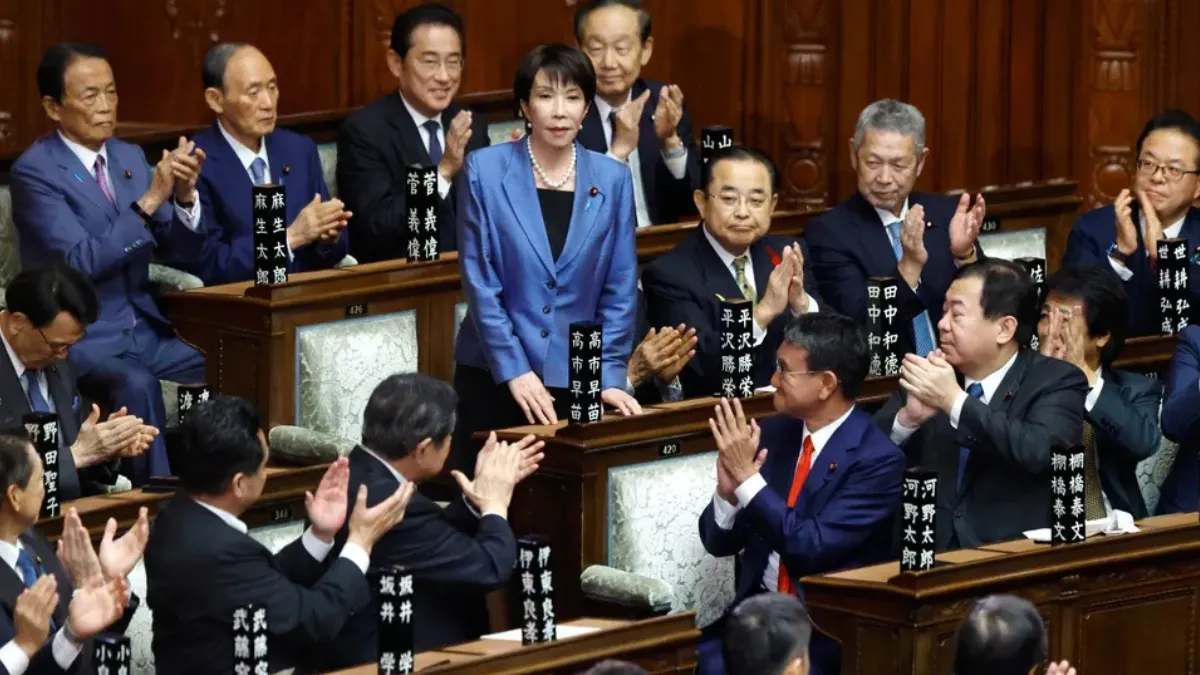A Historic Moment for Japan’s Politics
Japan 1st Woman PM Sanae Takaichi: Japan has entered a historic chapter with Sanae Takaichi becoming the nation’s first woman prime minister. Her appointment marks a significant milestone in Japanese politics, where female representation has long been limited. However, her cabinet announcement on Tuesday drew attention for another reason — despite earlier pledges to ensure gender equality, only two women were appointed to her 19-member cabinet.
Takaichi, who has often spoken about empowering women and reforming Japan’s traditional political culture, had previously said that her cabinet’s gender balance would be “comparable to Nordic countries,” which are globally recognized for their gender equality. But the final lineup tells a different story.
Two Female Ministers Among Nineteen
Among the newly appointed ministers, Satsuki Katayama made history as Japan’s first female finance minister. Katayama’s appointment is being seen as a major symbolic step for women in leadership, especially in Japan’s traditionally male-dominated financial and political sectors.
The second female minister, Kimi Onoda, was appointed as Economic Security Minister, a key portfolio focusing on national and international trade security. The cabinet list was officially announced by Chief Cabinet Secretary Minoru Kihara during a press briefing.
While these appointments mark small but meaningful progress, critics and gender equality advocates argue that two women out of nineteen is far from the “Nordic standard” Takaichi had promised.
A Leader Inspired by Margaret Thatcher
Sanae Takaichi, known for her conservative views and admiration for former British Prime Minister Margaret Thatcher, has often described herself as a reformist who believes in strong, principle-driven leadership. Her leadership style is expected to bring a firm stance on defense, economy, and Japan’s global relations, while also navigating domestic debates about gender roles.
In her first public address as prime minister, Takaichi emphasized that she intends to “serve all citizens equally” and ensure that Japan’s policies reflect both “strength and compassion.” Still, the gender composition of her cabinet has raised eyebrows among international observers and Japanese citizens alike.
Japan’s Gender Equality Gap Remains Wide
According to the World Economic Forum’s 2025 Gender Gap Report, Japan ranked 118th out of 148 countries, highlighting the persistent gender disparity in political and corporate leadership. Despite being one of the world’s most developed economies, Japan has struggled to promote women into top decision-making roles, both in government and in business.
In contrast, Nordic nations like Iceland, Finland, and Norway — the very countries Takaichi cited as models — ranked among the top three for gender equality, largely due to their balanced political representation and family-friendly workplace policies.
Analysts say Japan still faces deep-rooted social and structural barriers that discourage women from pursuing high-level political careers. Many hope that Takaichi’s rise to power will at least open new discussions about these issues, even if her first cabinet did not meet the expectations she set.
Also read: Who is Caroline Levitt? The White House Press Secretary Who Stirred Controversy with a Fiery Remark
Strong Foreign Policy and Economic Focus
In addition to her female appointments, Toshimitsu Motegi was named Foreign Minister. Motegi is widely respected for his diplomatic experience and was previously credited with finalizing a major trade deal with former U.S. President Donald Trump’s administration. His return to a top foreign policy role signals continuity and stability in Japan’s international relations.
Takaichi’s cabinet, overall, leans toward experienced policymakers and party loyalists, reflecting a strategy focused on maintaining internal stability while Japan faces global economic and security challenges.
Also read: Brexit Impact on UK Economy: A Detailed Analysis
Balancing Reform and Reality
While Japan 1st Woman PM Sanae Takaichi has achieved a groundbreaking milestone for gender representation by leading the country, her cabinet appointments show the gap between political promises and practical realities in Japan’s male-dominated power structure.
Supporters argue that her leadership alone is a powerful statement for women’s empowerment, and change will take time. Critics, however, warn that Japan risks falling further behind other developed nations if it does not take concrete steps toward inclusive governance.
As the world watches her next moves, Takaichi faces the dual challenge of proving her leadership strength and addressing the expectations she set for gender balance. Whether she can transform Japan’s political landscape or not, her historic rise already marks a turning point in the nation’s modern history.
















